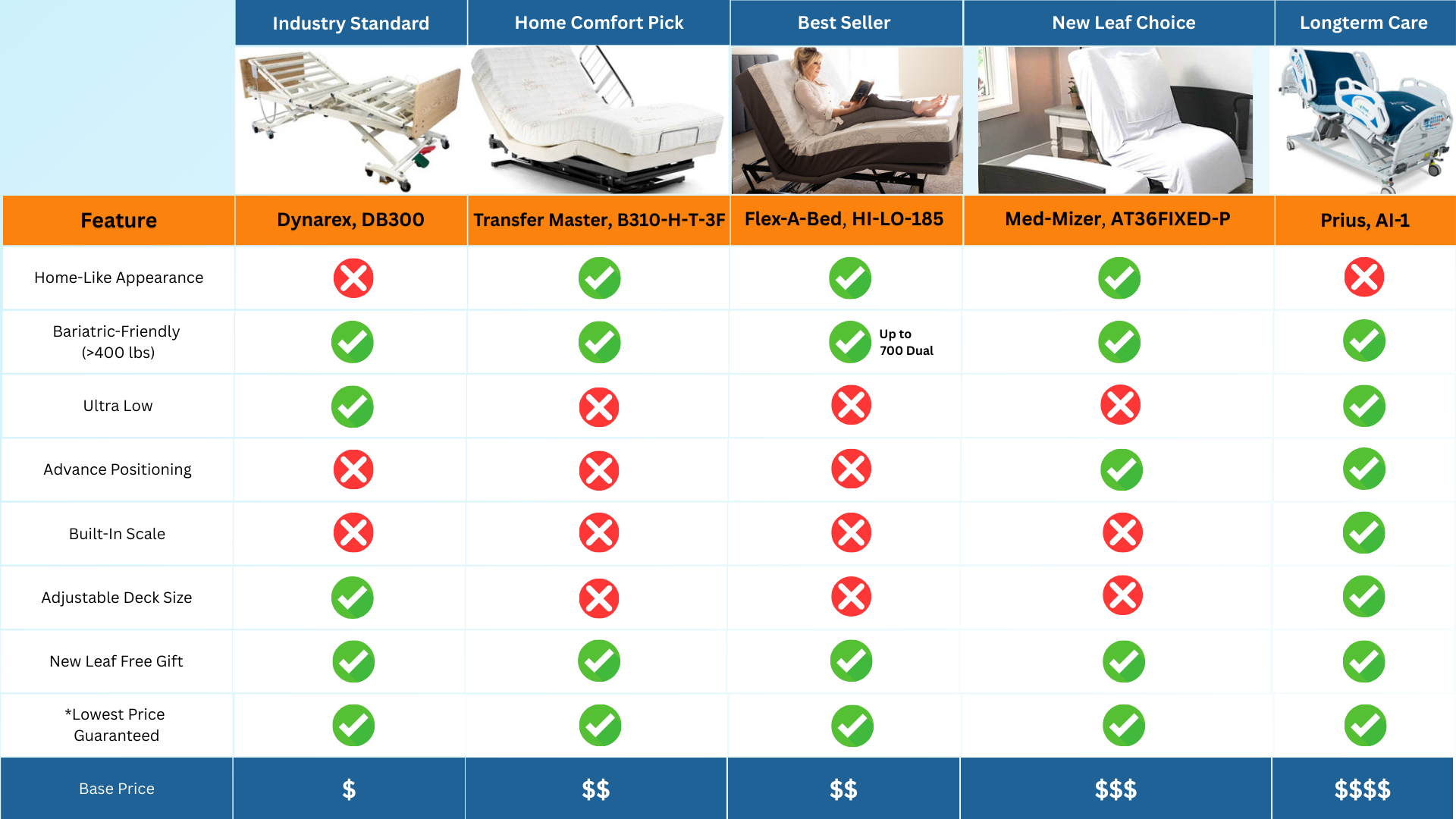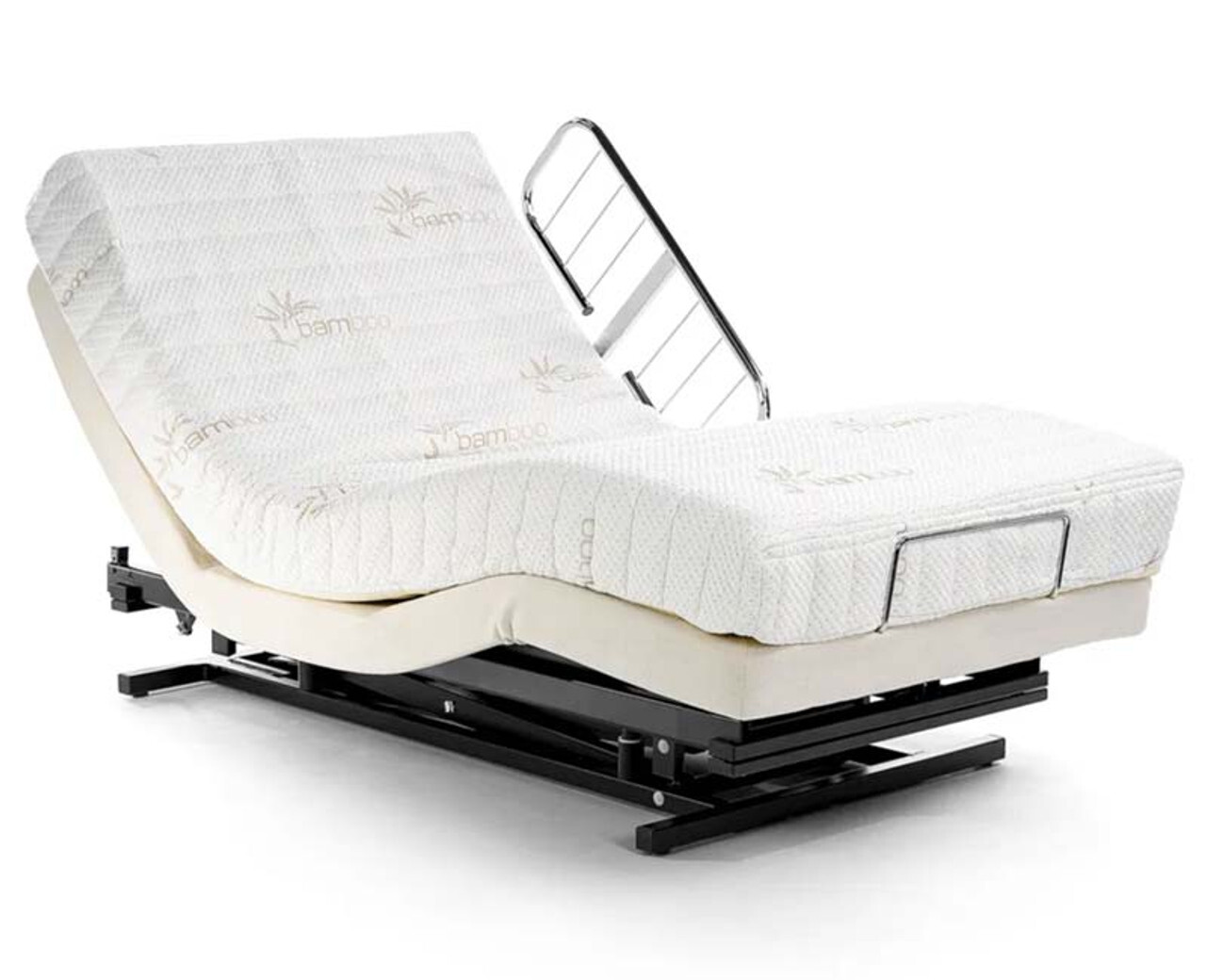FREE SHIPPING ON ORDERS OVER $75
Choosing the Right Hospital Bed for Home Use

When it comes to setting up a supportive and safe environment at home, choosing the right hospital bed is a vital step. For individuals with limited mobility, chronic conditions, or specific health needs, a hospital bed provides the essential comfort and adaptability needed for day-to-day living. However, with so many types and features available, finding the right one can feel overwhelming.
 Whether you are considering an adjustable bed, a budget-friendly option, or one with advanced functionality, this guide will help you navigate the key factors in selecting the ideal hospital bed. With an understanding of patient needs, room requirements, and budget considerations, you can make a well-informed choice that ensures both comfort and value.
Whether you are considering an adjustable bed, a budget-friendly option, or one with advanced functionality, this guide will help you navigate the key factors in selecting the ideal hospital bed. With an understanding of patient needs, room requirements, and budget considerations, you can make a well-informed choice that ensures both comfort and value.
Factors to Consider for Selection
Patient's Health Needs
The primary factor in choosing a hospital bed is the specific health needs of the patient. For those with conditions that require frequent repositioning, an adjustable bed offers flexibility and comfort, allowing easy changes in posture and position. If the patient needs assistance with mobility or is at risk of bedsores, selecting a bed with adjustable height and ergonomic features becomes crucial.
Consider also the patient’s level of independence. A bed with electric controls may be ideal for individuals who can manage adjustments independently, while manual beds could suit those with caregivers available for assistance.
Available Space in the Room
The space where the bed will be placed is another essential consideration. Hospital beds can vary in size, with some models offering additional width for comfort or features that require more room. Measure the area carefully to ensure the bed fits comfortably and allows enough space for caregivers to assist the patient without obstruction.
Think also about the room layout and any other furniture that may need rearrangement. Make sure there is sufficient clearance around the bed, especially if side rails or other accessories will be added.
Bed Functionality and Features
Hospital beds come with a range of functionalities that impact their ease of use and comfort level. Key features include head, foot, and height adjustments, which are essential for individuals needing specific support positions. For example, adjustable height can aid in safe transfers, while head and foot adjustments provide relief and prevent pressure points.
Consider any additional features that may enhance the bed’s functionality. Built-in safety rails, mattress compatibility, and motorized adjustments are all beneficial, especially for those with higher care needs or requiring frequent repositioning.
Patient Needs & Bed Types
Adjustable vs. Fixed Position Beds
Adjustable hospital beds offer flexibility, allowing users to change positions as needed to relieve pressure points or to help with mobility. This is particularly helpful for patients who spend long hours in bed, as position changes can help prevent discomfort and promote circulation. Fixed-position beds, while simpler and often more affordable, might not provide the same level of comfort for patients requiring regular adjustments.
Electric vs. Manual Beds
Electric beds allow patients or caregivers to adjust the bed's height, head, and foot positions with a remote, adding convenience and independence. Manual beds, on the other hand, require physical effort to make adjustments, which can be suitable for individuals with caregivers available for assistance or those on a budget. Electric beds are generally a better option for those needing frequent adjustments or with limited physical strength.
Specialized Options for Specific Needs
 Certain beds cater to specific needs, such as bariatric beds for individuals requiring additional support and space. For pediatric patients, child-friendly designs with additional safety features are ideal. High-low beds, which adjust both in height and at the head and foot, can be beneficial for individuals needing assistance with transfers or with a higher risk of falls.
Certain beds cater to specific needs, such as bariatric beds for individuals requiring additional support and space. For pediatric patients, child-friendly designs with additional safety features are ideal. High-low beds, which adjust both in height and at the head and foot, can be beneficial for individuals needing assistance with transfers or with a higher risk of falls.
Price vs. Features
Balancing Budget and Functionality
 When choosing a hospital bed, balancing cost with functionality is essential. Hospital beds can range from basic manual models to advanced electric beds with multiple features. If you have a limited budget, focusing on essential features—such as adjustable head and foot positions—may provide sufficient support without excessive cost. Semi-electric beds offer a balance of convenience and affordability by providing electric head and foot adjustments while maintaining manual height control.
When choosing a hospital bed, balancing cost with functionality is essential. Hospital beds can range from basic manual models to advanced electric beds with multiple features. If you have a limited budget, focusing on essential features—such as adjustable head and foot positions—may provide sufficient support without excessive cost. Semi-electric beds offer a balance of convenience and affordability by providing electric head and foot adjustments while maintaining manual height control.
Considering Long-Term Value
While budget constraints are a natural consideration, it’s essential to evaluate the long-term value of the bed. A slightly higher investment in features that enhance comfort, reduce caregiver strain, or improve safety can make a significant difference in the quality of life for both the patient and caregiver. Think about the bed as an investment in health, comfort, and care efficiency.
Additional Costs to Factor In
When budgeting for a hospital bed, consider additional costs like mattresses, side rails, and any other accessories that may improve comfort and safety. Some models may include these features, while others require separate purchases. Budgeting for accessories ensures a fully functional setup that meets all health and safety requirements.
Tips on Finding a Suitable Option
Prioritize Essential Features
Start by listing the essential features based on the patient's health needs, the available space, and the care requirements. Prioritizing what’s most important will make it easier to narrow down options. For example, if frequent position changes are necessary, an electric or semi-electric bed would be a priority.
Compare Models and Read Reviews
Research different models and read user reviews to understand how each bed performs in real-life settings. Reviews from other users can offer insights into ease of use, durability, and comfort, helping you make an informed decision. Comparing features side-by-side can also clarify which bed offers the best value for your specific needs.
Consult with Healthcare Providers
If possible, consult with a healthcare provider to get recommendations based on the patient’s medical condition. Professionals can advise on specific features that may benefit the patient, helping you avoid unnecessary features and ensuring that the bed provides adequate support and safety.
Final Thoughts
Choosing the right hospital bed for home use is a decision that directly impacts the comfort, safety, and quality of life of individuals needing additional support. By carefully considering factors like health needs, space, and budget, you can find a hospital bed that offers the right balance of functionality and affordability. Each bed type, from manual models to fully electric options, provides unique benefits, ensuring that a suitable option exists for everyone.
 Ultimately, the goal is to provide a supportive environment that promotes dignity, independence, and peace of mind. With the right hospital bed, home care becomes more manageable, allowing patients and caregivers to focus on well-being and recovery. A well-chosen hospital bed transforms the home into a place of comfort and care, enhancing quality of life for all involved.
Ultimately, the goal is to provide a supportive environment that promotes dignity, independence, and peace of mind. With the right hospital bed, home care becomes more manageable, allowing patients and caregivers to focus on well-being and recovery. A well-chosen hospital bed transforms the home into a place of comfort and care, enhancing quality of life for all involved.


